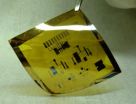(Press-News.org) An area of the brain called the orbitofrontal cortex is responsible for decisions made on the spur of the moment, but not those made based on prior experience or habit, according to a new basic science study from substance abuse researchers at the University of Maryland School of Medicine and the National Institute on Drug Abuse (NIDA). Scientists had previously believed that the area of the brain was responsible for both types of behavior and decision-making. The distinction is critical to understanding the neurobiology of decision-making, particularly with regard to substance abuse. The study was published online in the journal Science.
Scientists have assumed that the orbitofrontal cortex plays a role in "value-based" decision-making, when a person compares options and weights consequences and rewards to choose best alternative. The Science study shows that this area of the brain is involved in decision-making only when the value must be inferred or computed rapidly or hastily. If the value has been "cached" or pre-computed, like a habit, then the orbitofrontal cortex is not necessary.
The same is true for learning — if a person infers an outcome but it does not happen, the resulting error can drive learning. The study shows that the orbitofrontal cortex is necessary for the inferred value that is used for this type of learning.
"Our research showed that damage to the orbitofrontal cortex may decrease a person's ability to use prior experience to make good decisions on the fly," says lead author Joshua Jones, Ph.D., a postdoctoral researcher at the University of Maryland School of Medicine and a research scientist at NIDA, part of the National Institutes of Health. "The person isn't able to consider the whole continuum of the decision — the mind's map of how choices play out further down the road. Instead, the person is going to regress to habitual behavior, gravitating toward the choice that provides the most value in its immediate reward."
The study enhances scientists' understanding of how the brain works in healthy and unhealthy individuals, according to the researchers.
"This discovery has general implications in understanding how the brain processes information to help us make good decisions and to learn from our mistakes," says senior author Geoffrey Schoenbaum, M.D., Ph.D., adjunct professor at the University of Maryland School of Medicine and senior investigator and chief of the Cellular Neurobiology Research Branch at NIDA. "Understanding more about the orbitofrontal cortex also is important for understanding disorders such as addiction that seem to involve maladaptive decision-making and learning. Cocaine in particular seems to have long-lasting effects on the orbitofrontal cortex. One aspect of this work, which we are pursuing, is that perhaps some of the problems that characterize addiction are the result of drug-induced changes in this area of the brain."
The scientists are continuing their research, examining the specific coding of the neurons in the orbitofrontal cortex during this process, as well as the effects that drugs of abuse have upon this area of the brain.
"Drug addiction is marked by severe deficits in judgment and bad decision-making on the part of the addict," says Dr. Jones. "We believe that drugs, particularly cocaine, affect the orbitofrontal cortex. They coerce the system and hijack decision-making."
The researchers examined the orbitofrontal cortex's role in value-guided behavior. The brain assigns two different types of values to behaviors and choices. Cached value is a value that is learned during prior experience. Inferred value happens on the spur of the moment, considering the entire model of rewards and consequences.
"Cached value is stored during prior experience, says Dr. Jones. "For example, you learn your route home on your commute through experience — the habit of how you get home. You turn right, go left, make another right. Inferred values, however, are based on estimating goals and values on the fly using your knowledge of the entire structure of the environment. For example, instead of just habitually going home on your usual route, you have the full map in your mind of all the roads that you use. You can adjust your route, making different turns, depending on the time of day or the amount of traffic. These inferred decisions are adaptive — much more flexible based on the situation."
The scientists used a rat model for their research, disabling the orbitofrontal cortex and measuring the difference in behavior that resulted. Further study using the same rat model — work not reported in this paper — has shown that cocaine use mimics this damage to the orbitofrontal cortex.
Further study of this neurobiological mechanism is needed, and the results have not been replicated in humans, but certainly the research is promising, says E. Albert Reece, M.D., Ph.D., M.B.A., vice president for medical affairs at the University of Maryland and John Z. and Akiko K. Bowers Distinguished Professor and dean at the University of Maryland School of Medicine. "Our goal here at the School of Medicine is to make groundbreaking discoveries in the laboratory that can be translated into new treatments and new hope for patients and their families," says Dean Reece. "We are hopeful that research tells us more about the basic mechanisms in the brain will translate to new techniques in neurobiology and in treating devastating conditions such as drug addiction."
###
About the University of Maryland School of Medicine
Established in 1807, the University of Maryland School of Medicine is the first public medical school in the United States, and the first to institute a residency-training program. The School of Medicine was the founding school of the University of Maryland and today is an integral part of the 11-campus University System of Maryland. On the University of Maryland's Baltimore campus, the School of Medicine serves as the anchor for a large academic health center which aims to provide the best medical education, conduct the most innovative biomedical research and provide the best patient care and community service to Maryland and beyond. www.medschool.umaryland.edu.
END
SAN DIEGO, Calif. (November 26, 2012) The Algae Biomass Organization, the trade association for the U.S. algae industry today hailed the findings of a University of California at San Diego study that concludes, for the first time, that marine (saltwater) algae can be just as capable as freshwater algae in producing biofuels. The research is documented in a peer-reviewed paper published online in the current issue of the scientific journal Algal Research.
"What this means is that you can use ocean water to grow the algae that will be used to produce biofuels. And once ...
EAST LANSING, Mich. — Where there's water there's life – even in brine beneath 60 feet of Antarctic ice, in permanent darkness and subzero temperatures.
While Lake Vida, located in the northernmost of the McMurdo Dry Valleys of East Antarctica, will never be a vacation destination, it is home to some newly discovered hearty microbes. In the current issue of the Proceedings of the National Academy of Sciences, Nathaniel Ostrom, Michigan State University zoologist, has co-authored "Microbial Life at -13ºC in the Brine of an Ice-Sealed Antarctic Lake."
Ostrom was part ...
The wild and dramatic cascade of ice into the ocean from Alaska's Columbia Glacier, an iconic glacier featured in the documentary "Chasing Ice" and one of the fastest moving glaciers in the world, will cease around 2020, according to a study by the University of Colorado Boulder.
A computer model predicts the retreat of the Columbia Glacier will stop when the glacier reaches a new stable position -- roughly 15 miles upstream from the stable position it occupied prior to the 1980s. The team, headed by lead author William Colgan of the CU-Boulder headquartered Cooperative ...
SEATTLE—After gastric bypass surgery, diabetes goes away for some people—often even before they lose much weight. So does that mean gastric surgery "cures" diabetes? Not necessarily, according to the largest community-based study of long-term diabetes outcomes after bariatric surgery. For most people in the study, e-published in advance of print in Obesity Surgery, diabetes either never remitted after gastric surgery or relapsed within five years.
Among the two thirds of the study's patients whose diabetes at first went away, more than a third re-developed diabetes again ...
They say that the eyes are the windows to the soul. However, to get a real idea of what a person is up to, according to UC Santa Barbara researchers Miguel Eckstein and Matt Peterson, the best place to check is right below the eyes. Their findings are published in the Proceedings of the National Academy of Sciences.
"It's pretty fast, it's effortless –– we're not really aware of what we're doing," said Miguel Eckstein, professor of psychology in the Department of Psychological & Brain Sciences. Using an eye tracker and more than 100 photos of faces and participants, Eckstein ...
PHILADELPHIA — Electronic circuits are typically integrated in rigid silicon wafers, but flexibility opens up a wide range of applications. In a world where electronics are becoming more pervasive, flexibility is a highly desirable trait, but finding materials with the right mix of performance and manufacturing cost remains a challenge.
Now a team of researchers from the University of Pennsylvania has shown that nanoscale particles, or nanocrystals, of the semiconductor cadmium selenide can be "printed" or "coated" on flexible plastics to form high-performance electronics.
The ...
You may have received CPR training some time ago, but would you remember the proper technique in an emergency? Would you know what to do in the event of an earthquake or a fire? A new UCLA psychology study shows that people often do not recall things they have seen — or at least walked by — hundreds of times.
For the study, 54 people who work in the same building were asked if they knew the location of the fire extinguisher nearest their office. While many of the participants had worked in their offices for years and had passed the bright red extinguishers several times ...
Johns Hopkins researchers report concrete steps in the use of human stem cells to test how diseased cells respond to drugs. Their success highlights a pathway toward faster, cheaper drug development for some genetic illnesses, as well as the ability to pre-test a therapy's safety and effectiveness on cultured clones of a patient's own cells.
The project, described in an article published November 25 on the website of the journal Nature Biotechnology, began several years ago, when Gabsang Lee, D.V.M., Ph.D., an assistant professor at the Johns Hopkins University School ...
ITHACA, N.Y. – Are juicier, sweeter, more disease-resistant watermelons on the way? An international consortium of more than 60 scientists from the United States, China, and Europe has published the genome sequence of watermelon (Citrullus lanatus) — information that could dramatically accelerate watermelon breeding toward production of a more nutritious, tastier and more resistant fruit. The watermelon genome sequence was published in the Nov. 25 online version of the journal Nature Genetics.
The researchers discovered that a large portion of disease resistance genes ...
DURHAM, N.C. -- One tropical lizard's tolerance to cold is stiffer than scientists had suspected.
A new study shows that the Puerto Rican lizard Anolis cristatellus has adapted to the cooler winters of Miami. The results also suggest that this lizard may be able to tolerate temperature variations caused by climate change.
"We are not saying that climate change is not a problem for lizards. It is a major problem. However, these findings indicate that the thermal physiology of tropical lizards is more easily altered than previously proposed," said Duke biologist Manuel ...



